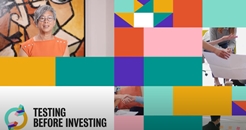 Pursuing failure to test innovations
Pursuing failure to test innovations
From an article by Spring Impact
Ann Mei Chang, CEO of Candid and author of Lean Impact, explains that the true determinant of success lies not in the perfection of your initial ideas. But in how quickly and effectively you can learn from testing them.
Testing before Investing sounds like a pretty simple mindset, but I found that it's incredibly difficult for most people to grasp, and the reason for that is that we grow up our entire lives trying to avoid failure. However, with Testing before Investing we're asking you to do the opposite. We're asking you to pursue failure.
That might sound kind of counterintuitive, but the reason we want to pursue failure is because if we're going to fail, we want to fail early, and we want to fail small. That allows us to learn, adapt and iterate to get to a solution that has the potential to really solve the problem that you're trying to solve.
I don't think there's any one moment where I realized that Testing before Investing is mission-critical. I think it was something that I came to over time as I learned more about the wide range of efforts out there to do good in the world and saw over and over again how so many of them were only meeting a fraction of the need. Most of them weren't getting to the root causes of the problems they were trying to solve.
One of the reasons that became clear to me, was that many of these teams are working with their arms tied behind their backs. They have a detailed plan that they're expected to execute and deliver on, and very little flexibility to learn and adapt based on changing conditions or what they're finding as they're doing their work.
As a result, we can end up wasting an enormous amount of resources.
I think Testing before Investing is much harder in the social sector than it is in the private sector. In the social sector, we're trying to solve real people's pressing problems. We can't put that off by experimenting and looking for better solutions. We're talking about vulnerable people, and so I think there's a hesitation to try different things, to figure out what might work, and so therefore we get a little gun shy.
Whereas in the private sector, the people who we're trying to offer goods or a service to, are often typically the people who are also paying for that, so there's a very direct feedback loop. In the social sector, it's a lot harder because when I offer goods or a service, typically the person paying for it is a funder somewhere else, and so the feedback loop becomes much more complicated.
And there's two things I think that are critical from a funding standpoint.
One is that we have flexible funding, because when we have funding that's so restrictive, it doesn't leave us room to be able to iterate and adapt our solutions and learn as we go.
But flexible funding isn't sufficient in and of itself. In addition to flexibility, we need the incentive to innovate, because people are naturally risk-averse, afraid to fail. That incentive gets people out of their comfort zone, to try to take those bigger swings, to try ideas that might fail in the pursuit of something that's much much better.
I truly believe that if we add the Testing before Investing mindset into our tool chest, the sector as a whole, could have two times, maybe even 10 times as much impact on the problems that we care about in the world.
Watch this 4 min video:
Read the article here.
How's our innovation mindset when we try something new in social action/ministry?
Retweet about this article:
From an article by Spring Impact, 25/09/2024